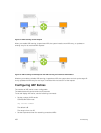
25
IPv6 Routing
Internet protocol version 6 (IPv6) routing is the successor to IPv4. Due to the rapid growth in internet
users and IP addresses, IPv4 is reaching its maximum usage. IPv6 will eventually replace IPv4 usage to
allow for the constant expansion.
This chapter provides a brief description of the differences between IPv4 and IPv6, and the Dell
Networking support of IPv6. This chapter is not intended to be a comprehensive description of IPv6.
NOTE: The IPv6 basic commands are supported on all platforms. However, not all features are
supported on all platforms, nor for all releases. To determine the Dell Networking OS version
supporting specific features and platforms, refer to
Implementing IPv6 with Dell Networking OS.
Protocol Overview
IPv6 is an evolution of IPv4. IPv6 is generally installed as an upgrade in devices and operating systems.
Most new devices and operating systems support both IPv4 and IPv6.
Some key changes in IPv6 are:
• Extended address space
• Stateless autoconfiguration
• Header format simplification
• Improved support for options and extensions
Extended Address Space
The address format is extended from 32 bits to 128 bits. This not only provides room for all anticipated
needs, it allows for the use of a hierarchical address space structure to optimize global addressing.
Stateless Autoconfiguration
When a booting device comes up in IPv6 and asks for its network prefix, the device can get the prefix (or
prefixes) from an IPv6 router on its link. It can then autoconfigure one or more global IPv6 addresses by
using either the MAC address or a private random number to build its unique IPv6 address.
Stateless autoconfiguration uses three mechanisms for IPv6 address configuration:
• Prefix Advertisement — Routers use “Router Advertisement” messages to announce the network
prefix. Hosts then use their interface-identifier MAC address to generate their own valid IPv6 address.
• Duplicate Address Detection (DAD) — Before configuring its IPv6 address, an IPv6 host node device
checks whether that address is used anywhere on the network using this mechanism.
• Prefix Renumbering — Useful in transparent renumbering of hosts in the network when an
organization changes its service provider.
NOTE: As an alternative to stateless autoconfiguration, network hosts can obtain their IPv6
addresses using the dynamic host control protocol (DHCP) servers via stateful auto-configuration.
IPv6 Routing
459


















